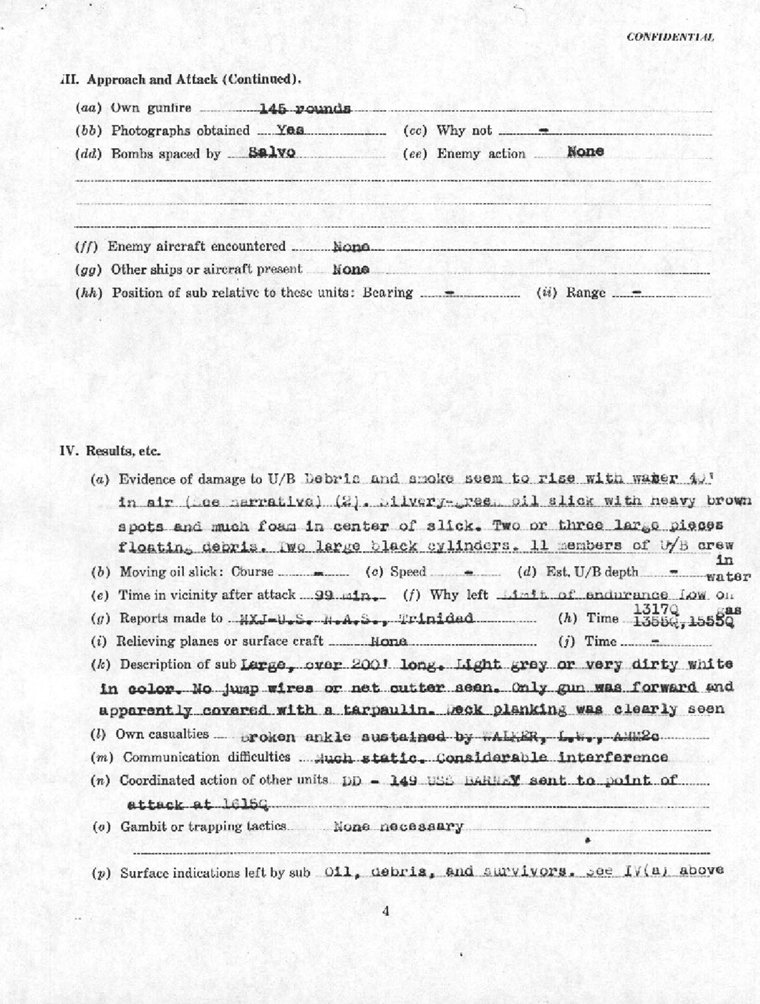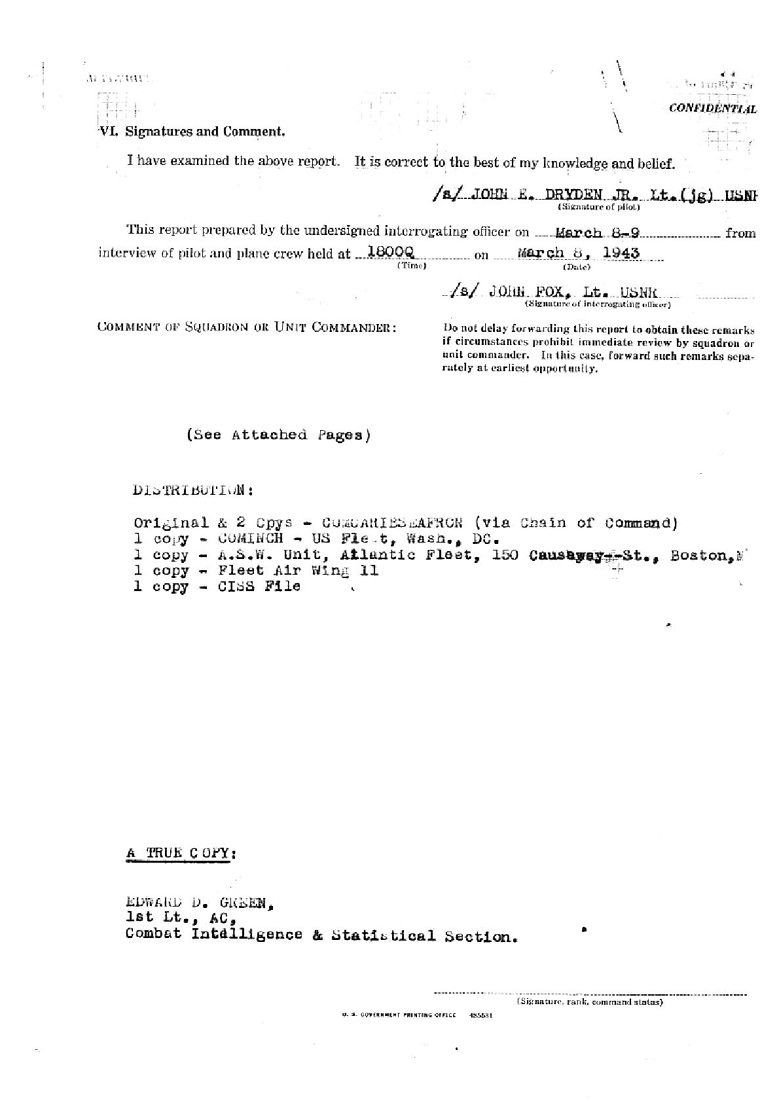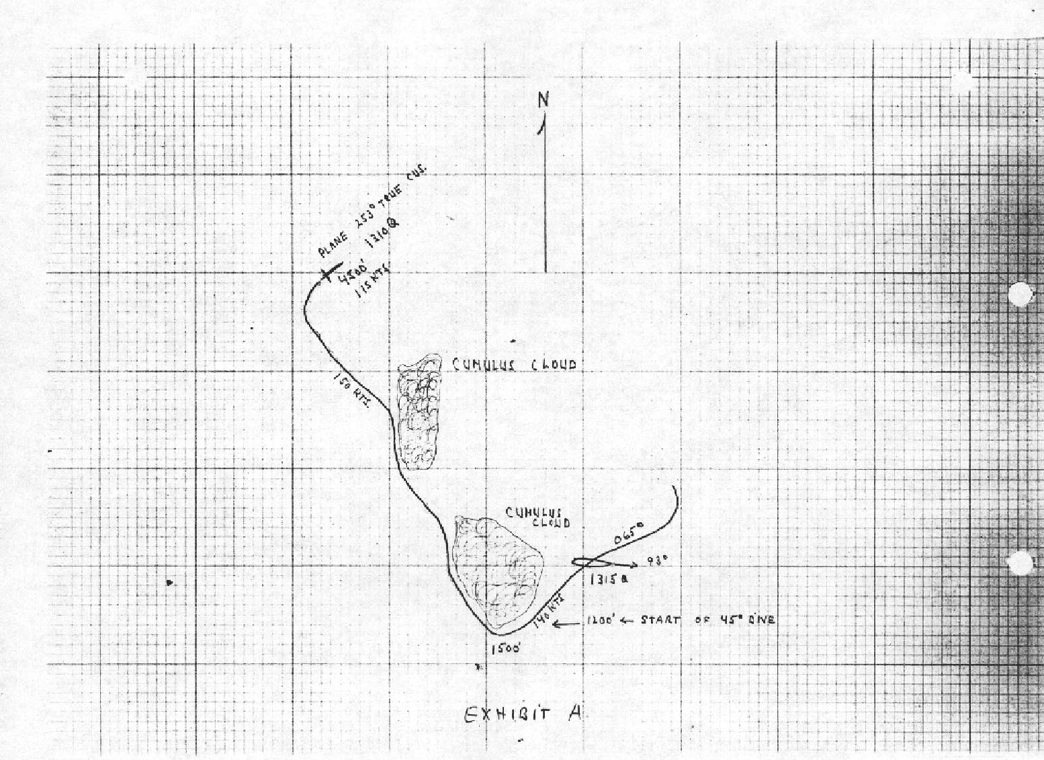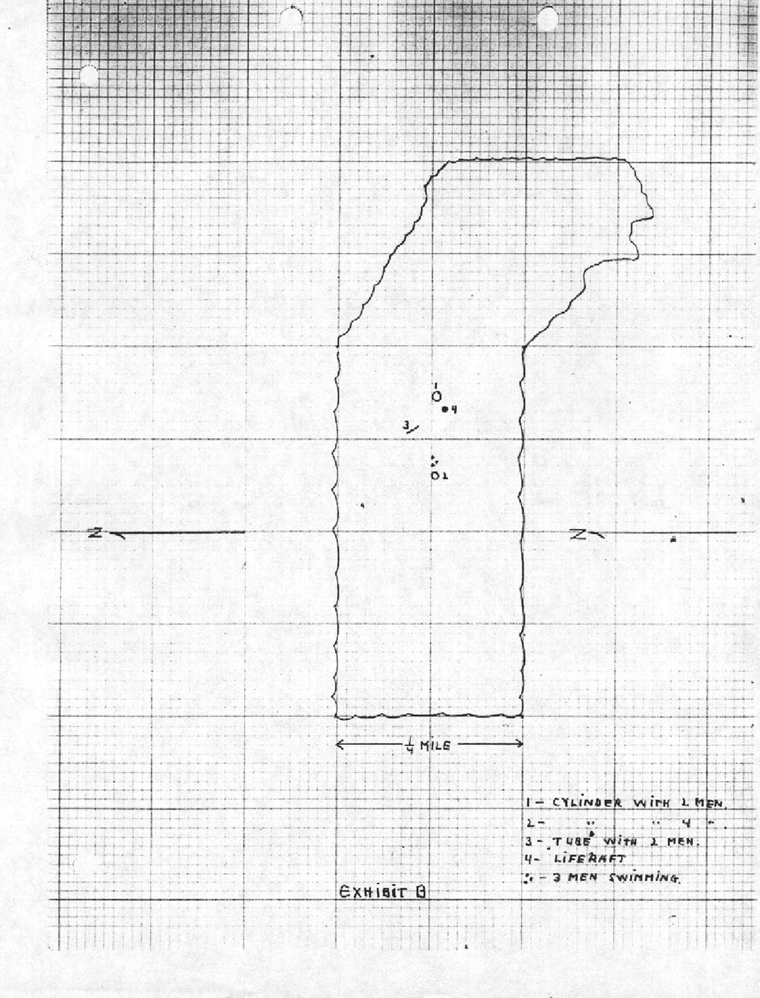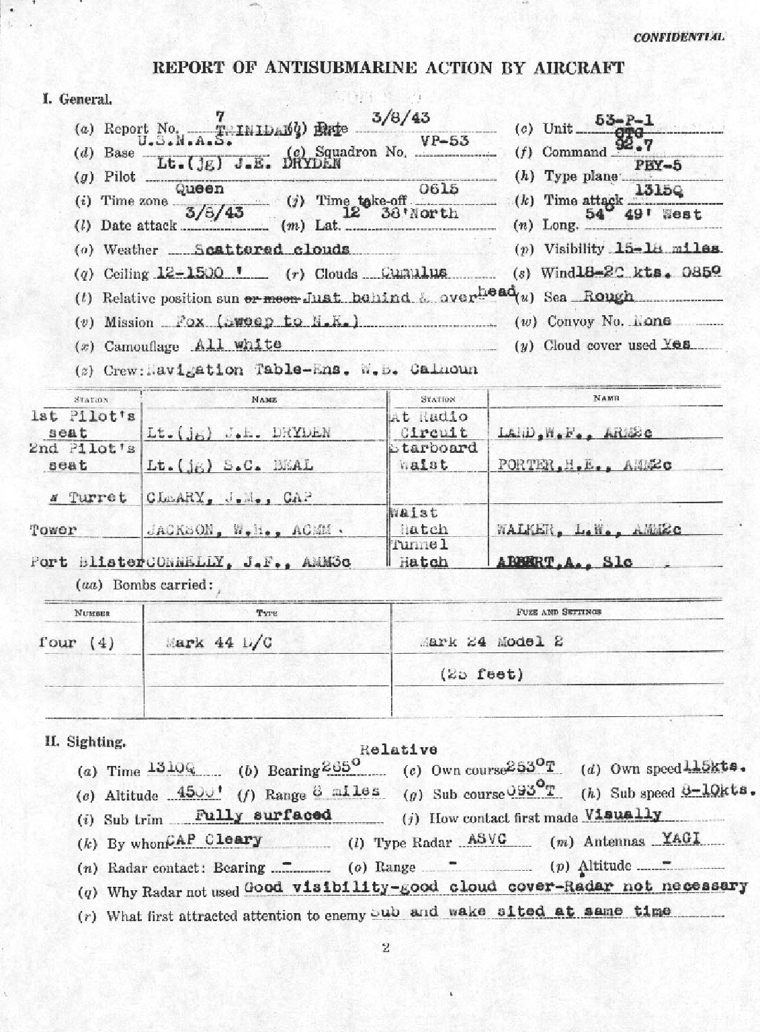
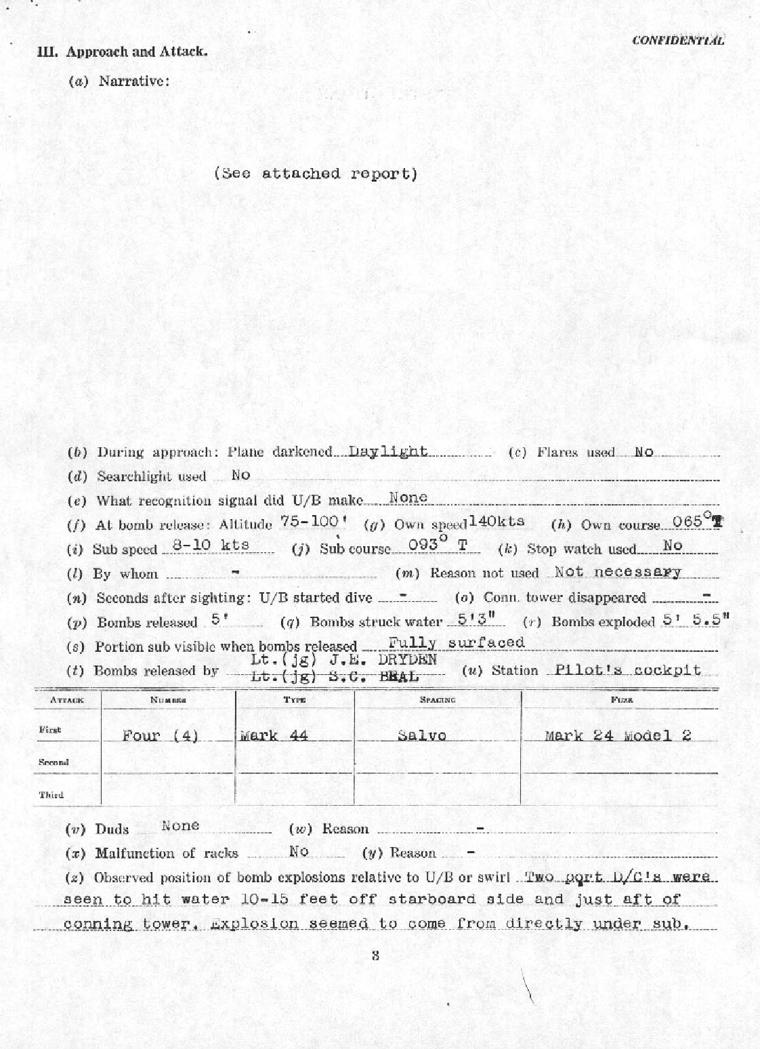
| III. APPRAOCH AND ATTACK. (See paragraph in Form ASW-6) | ||
(a) NARRATIVE |
||
| PSP 53-P-1 with CAP J. M. CLEARY in the first pilot's seat while on an anti-submarine patrol (Mission Fox, a patrol ordered by NOB operations) on March 8, 1943, sighted a submarine fully surfaced at 1310Q. At the time of the sighting the plane was flying at an altitude of 4500 feet, true air speed 115 knots, on a course of 253° True, position 12-38N 54-49W. The U/B was sighted by CAP CLEARY bearing 255° (relative) from the plane, 8 miles distant, its course 093° True, its speed between 8 and 10 knots. | ||
| Less than a minute after the sighting PPC Lt. (jg) J. E. Dryden took over the controls. CAP CLEARY had left the seat to take his position at the bow gun. Lt. (jg) Dryden had been in the navigation compartment at the time of the sighting. Four miles from the submarine, the PPC was able to make use of cloud cover by turning slightly right and ducking behind one cloud and later a second one. At 1/4 miles from the submarine the plane left the cloud cover at an altitude of 1500 ft. - pushing over into a dive of 45° from an altitude of 1200 ft. a few seconds later. The final approach, immediately prior to the drop, was made on a course of 065 True. The maximum speed reached was 150 knots while descending to the first cloud. Speed of the plane in the final dive was 140 kts. The sun was directly behind the plane and almost overhead. At 1315Q, four (4) Mark 44 Torpex D/C's were dropped manually from an altitude of 75 to 100 feet just as the plane started to pull out of its dive. The PPC and Second Pilot, Lt. (jg) S. C. Beal, pulled the two manual release switches simultaneously thus causing a drop in salvo. | ||
| CONNELY, J. F., AMM3c on station at the port waist gun saw the two port D/C's leave their racks and hit the water 10-15 feet to starboard and just aft of the submarine lift, break in two in the middle, the center sections going under water first, the bow and stern rising into the air and then going under. Practically simultaneously a high order explosion occurred causing debris, smoke, and water to cascade 30 to 40 feet into the air in great profusion. One large tubular piece was particularly noticeable. It was approximately 6 feet long and one foot in diameter. | ||
| OIL SLICK | ||
| Immediately after the explosion a large patch of foam, 150-200 feet across, appeared and stayed on the surface for 4 to 5 minutes after the attack. At the same time a silvery green oil slick appeared around the foam. After the foam subsided, several splotches of heavy brown oil were seen in the center of the slick which kept expanding during the hour and thirty-nine minutes the plane was in the area after the attack. It is agreed that the slick was rectangular in shape, 3/4 mile long and 1/4 mile wide. The majority of the pictures were taken over the area of the slick - many white caps obtained outside this area. All objects of wreckage and survivors were inside the oil slick. | ||
| SURVIVORS | ||
| There were at least eleven survivors sighted, swimming or clinging to wreckage, immediately after the attack -- 2 on a upright black buoy or cylinder, 3 in the water swimming, and 4 clinging desperately to another black cylinder (similar to the first) 8-10 feet long, that was floating 500 feet away. One hundred yards to the North, 2 men were seen clinging desperately to a torpedo-like silver-colored cylinder. | ||
| The last two men disappeared almost immediately and the silver-colored cylinder 10-15 minutes later. THe four men on the horizontal black cylinder also disappeared leaving five ultimate survivors. The three men swimming were seen to reach the first mentioned upright buoy. | ||
| RESCUE EFFORTS | ||
| Immediately after the drop, second pilot, Lt. (jg) Beal, went aft to the Port Blister and got ready to take pictures. As the plane made its first run on the patch of foam he took six pictures and then on instructions from the pilot, prepared the Mark II, type D life raft and on the second run, just as the foam was subsiding, made a drop. This raft landed 30-40 feet from the upright buoy. At least one man was seen to swim over to the raft. Shortly thereafter two, then three, men were seen in the raft and finally five. How these men reached the raft was undetermined. | ||
| Ten minutes after the first raft was dropped, a Mark IV Type 3 raft was dropped. It did not inflate and although it landed 50-75 feet from the first raft and remained afloat, the survivors on the raft apparently did not see it as they made no attempt to row towards it. By this time all five of the survivors had reached the 2-man raft. Three were sitting on the raft and two were in the water hanging on. (See pictures). | ||
| RESCUE EFFORTS (CONT'D) | ||
| Ten minutes before leaving the area and emergency ration kit was tied to two Mae West Life Jackets, the jackets inflated; and the package dropped from the port blister, hitting the water 40 to 50 feet from the raft. The survivors were seen to row toward the ration kit and it is believed that they reached it. | ||
| In dropping the Mark II Type D buoy - the raft was first taken from its case and one of the plane's sea anchors attached with five (5) feet of line to prevent the raft from drifting with the wind. The bundle was then pushed through the tunnel hatch while Lt. (jg) Beal held on to the rip cord handle of the CO2 bottle that was attached to the raft. As the bundle left the plane, the raft started to inflate. | ||
| The same procedure was followed in dropping the larger raft, although no sea anchor was attached. However, because of the difference in type it was necessary to attach a foot and a half of line to the small 1-1/2" lever on the CO2 bottle. Lt. (jg) Beal was afraid to break the seal in the plane as he believed the raft would catch in the tunnel and puncture the CO2 bottle. Instead the line apparently slipped off the lever failing to trip it and the raft never inflated. | ||
| GUN FIRE | ||
| CAP CLEARY in the bow turret opened fire while 300 yards from the submarine flying a total of 100 rounds of 30 calibre ammunition. There was a man in reclining position of the platform aft of the submarine's conning tower. This man never got up from this position although CLEARY believed he started to do so just before he was hit. Another man was seen by CLEARY on the deck just forward of the gun. This man made a start forward, then threw up his hands and pitched forward onto the deck as if knocked down by the gun fire. The last burst from the gun was seen to go directly down the open conning tower. | ||
| CONNELLY in the port blister fired 15 rounds of 50 calibre ammunition, all of which were believed to have hit inside the conning tower. | ||
| A. ALBERT, S1c, in the tunnel hatch fired 30 rounds of 30 calibre ammunition between the conning tower and the bow. | ||
| DESCRIPTION OF U/B | ||
| The submarine was probably a 517 ton German submarine. It was described as light grey throughout and just over 200 feet long. The only gun seen was forward bur seemed to be covered by a tarpaulin. There was a definite bulge in the deckline around the gun and a railing was noticed. There was a low platform aft of the main part of the conning tower. No railing was seen here. The planking on the deck was definitely distinguishable. No jump wires or net cutter were observed. Because of cloud cover and steepness and speed of dive, no other details are available - the bow man supplying most of the information. | ||
| DESCRIPTION OF SURVIVORS | ||
| Of the five final survivors, four were clad only in shorts of bathing trunks; the fifth, possibly an officer, was clothed in a shirt as well. He was heavier and apparently older than the others, who all appeared to be in their late teens. One man was seen to shake his fist. | ||
| DEBRIS | ||
| Throughout the oil slick were many small pieces of debris. In addition to the two cylinders and torpedo-like piece already mentioned, there were one or two other large pieces - one of which was angular and jutted out of the water diagonally. It was covered with oil. | ||
| COMMUNICATIONS | ||
| Immediately after the sighting at 1310Q, W. F. LAND, ARM2c turned on his transmitted preparatory to sending a contact report. The starboard fuse then blew and it was necessary to start the "put-put" to operate the transmitter. LAND started his message as the plane went into its final dive from 1200 feet. His hand froze to the key during the pull-out and he finished his message during the first circling of the area. Estimated completion of message 1317Q. THis message was never receipted for and was not received by NXJ. | ||
| At 1355Q the first pilot approved the amplifying report that LAND drew up and the message was transmitted on 8210 kcs., trailing antennae wire being used. This message was receipted for at 1408Q. | ||
| It required 38 minutes for LAND to clear the circuit of interference from other planes and to prepare the message. LAND finally obtained a clear circuit by keeping his key down for 90 seconds. | ||
| The plane never received the call-up from NXJ. Communications were bad throughout the day. There was considerable interference and static. Plane's reception strength (from NXJ) was between 1 and 2. | ||
| Plane's ETA was sent at 1555Q. Receipted for at 1558Q. | ||
| PHOTOGRAPHS | ||
| Seventeen photographs were taken at various intervals during the 99 minutes the plane was in the area after the attack. A K-20 Navy camera was used from an altitude of 200 to 400 feet. Pertinent pictures are attached to this report. | ||
| MISCELLANEOUS | ||
| It is interesting to note that a Spanish cargo vessel, the "ALDECOA ESPANA", was sighted at 1045Q on the outward leg of the mission. Its course 270°; its speed 12 knots; its position 11-44 North 56-35 West. | ||
| Also at 1115Q the Spanish tanker "GOBEO" was sighted, course 270°, speed 8 knots, Latitude 11-11N, Longitude 56-02W. | ||
| REMARKS: | ||
| This attack is considered excellent in every respect for it combined a high degree of all the precepts of anti-submarine doctrine that this squadron has endeavored to stress in its training. It is of particular interest to note the following: (1) Altitude of plane at sighting was 4500 feet above broken clouds; (2) Camouflage (plane) solid white; (3) Maximum use of cloud cover during approach. While no one of the above listed factors can be pointed out as the primary reason for so successful an attack, it is believed that the combination of the three resulted in surprise so complete that the first indication the submarine had of a plane in the vicinity was the opening of fire by the plane's bow gun. | ||
| It is of further interest to note that the bombs were dropped in salvo as the intervalometer was inoperative, and it is felt that the cumulative effect of four bombs exploding in salvo resulted in complete destruction of the submarine whereas an intervalometer drop might have resulted in destruction of the submarine and it might not. On 1 January 1943, a plane of this squadron dropped three Mk 29 D.C.'s (one hung up) with 25' setting on a submarine whose conning tower was still awash. The drop was made by intervalometer with a stick setting of 60 feet at 150 knots. The drop was made as the plane passed over the sub from the port quarter to the starboard bow at a relative angle of ten degrees to the sub's course. The drop was a perfect straddle, one bomb exploding on port side and just abaft conning tower, one bomb exploding just forward of and on starboard side of conning tower, both explosions occurring within so-called lethal range (24 feet), while the third bomb exploded an estimated 30 to 40 feet away from sub's starboard bow. Oil and air bubbled to the surface with no forward motion for approximately 25 minutes. Assessment of this attack by Cominch Assessment Board was "Probable Slight Damage" which indicates (a) lethal range for these bombs is much less than had been anticipated or (b) a greater concentration of bombs within lethal range is necessary to severely damage or sink the submarine. It is not my intention to recommend discarding the intervalometer for it is felt that it is indispensable under the following conditions: | ||
| (1) At night when visibility conditions are such that it is difficult to judge distance. | ||
| (2) At any time when a submarine is fully submerged and the only point of aim is the swirl. | ||
| It is felt however, that conditions can prevail during an attack when a salvo drop is preferable to an intervalometer drop, and such conditions will exist when the target is a fully surfaced submarine. The general feeling among | ||
- 1 - |
||
| pilots of this squadron is that they stand a much better chance of definite kill by a salvo drop under this one condition than by use of the intervalometer. | ||
| This squadron has conducted rather intensive training in making practice drops on a towed target, and it is believed that all patrol plane commanders would be fully competent to make a successful attack on a fully surfaced submarine by using a salvo release. | ||
| One further point of interest in this attack was the effective use of machine gun fire. The bow gunner and the port waist gunner got in some very effective firing during the approach, and it is believed that two men were hit. | ||
| C. S. WINTER, Jr., | ||
| Lieutenant, U. S. Navy | ||
| Commanding. | ||
C-O-N-F-I-D-E-N-T-I-A-L |
||
| FURTHER REMARKS | ||
| 1. Remarks by the Commanding Officer Patrol Squadron 53 concurred in. This Squadron shows proper indoctrination in flying altitude, in the use of all elements of surprise, that is, attacking out of the sun and very clever use of cloud coverage. The cloud formation in this area is such that by flying between 4,000 and 6,000 feet excellent cloud coverage is afforded without particularly restricting visibility of the combat crew. By flying at this altitude the radar, particularly those employed on Army airplanes in this area, may be reduced somewhat in efficiency; but even though a radar contact is gained on a submarine at a range up to thirty miles, a visual sighting will usually take place 8 or 10 miles away which is sufficient distance to decrease altitude, initiate the attacks, and drop the depth bomb 50 feet altitude or below. In my opinion, the decreased efficiency of radar flying at this altitude is more than overcome by the element of surprise. | ||
| 2. Anti-submarine units stationed at Trinidad all receive the same type of training, the methods employed being attacks on a towed spar, the use of radar in attacks on the S-44, the attacks on our stationary bombing target. During the recent lull of submarine activity in this area training was increased for all combat crews on the methods mentioned above. This increased training has proved invaluable because the conduct of our combat crews in attacking submarines in the last three attacks has been exemplary. It has been further felt that much more time should be spent in training our combat crews but with the shortage of equipment and the anticipated increase in submarine activity in this area it will be impossible to devote too much time to this valuable phase of our combat activities. However, the extreme value of training is appreciated by all A/S Commanders and to that end all equipment that can be spared without impairing our tactical efficiency will be used for training. | ||
| 3. The advantages and disadvantages in dropping in salvo and in train, considering each type of aircraft employed, are now being extensively studied. Each drop has its advantages and disadvantages. We are endeavoring to set down desirable uses of each methods of attack, adhering to the principle of simplicity. A full report and conclusions drawn will be forwarded you at an early date. | ||
| CHAS. F. BORN, | ||
| Colonel, Air Corps, | ||
| Air Operations Officer. | ||
C-O-N-F-I-D-E-N-T-I-A-L |
||
